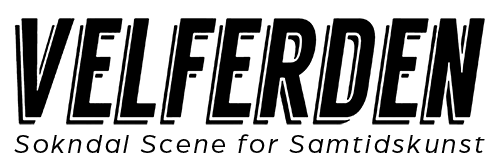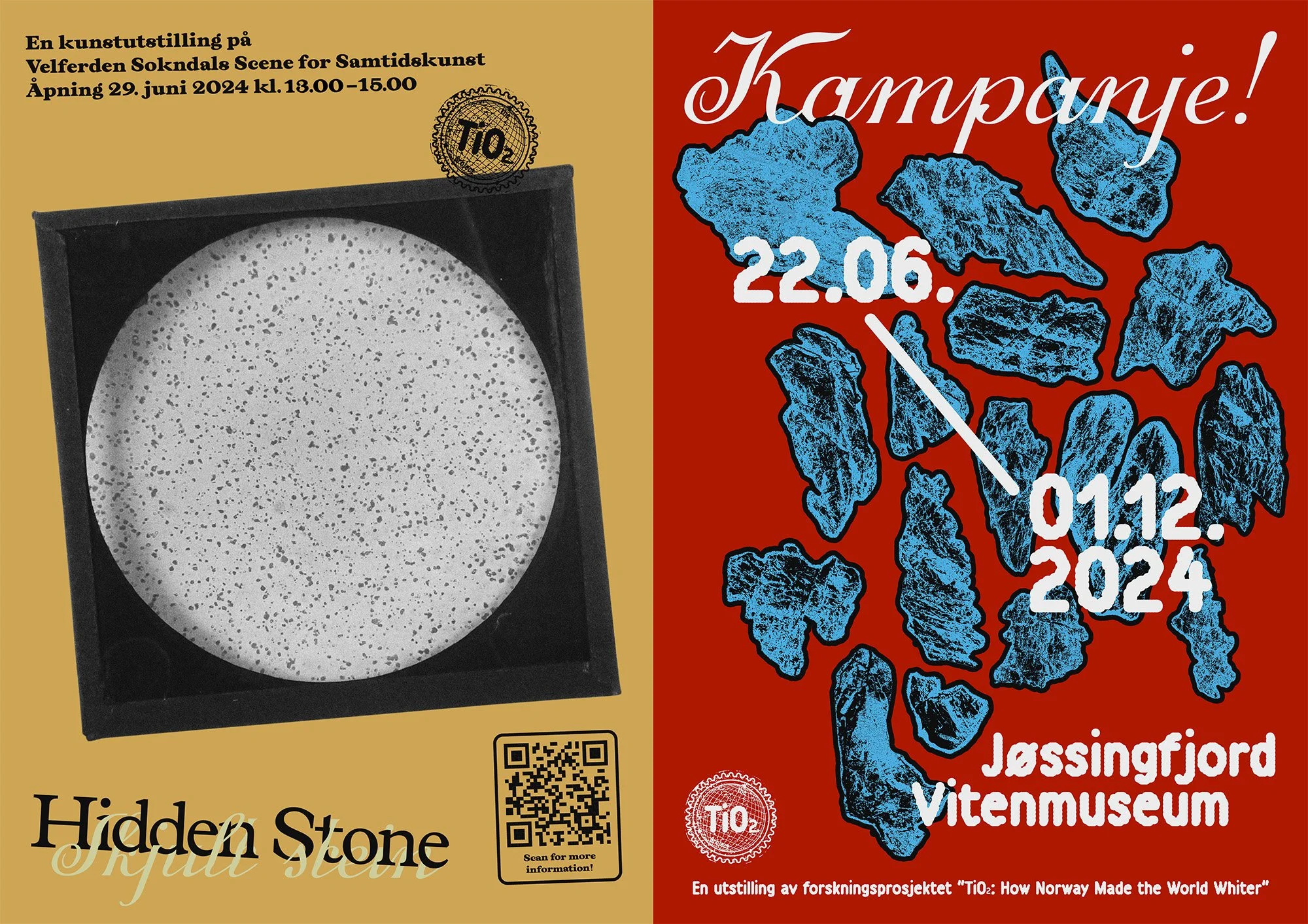EXHIBITIONS THIS SUMMER: Hidden Stone / Campaign!
Velferden: HIDDEN STONE / SKJULT STEIN and Jøssingfjord Science Museum: PROMOTION!
---------------------------------------------------
Are you curious about where the color white comes from? Do you want to know more about the history of Titania? Would you like to see how artists use pigments and waste sand from landfills and mines in their artwork?
This summer you can see two parallel exhibitions about this; "Campaign!" at Jøssingfjord Science Museum, and "Hidden Stone" at Velferden.
ABOUT THE EXHIBITIONS:
〰️
ABOUT THE EXHIBITIONS: 〰️
CAMPAIGN!
at Jøssingfjord Science Museum, 29.06.24 - 01.12.24
An exhibition with archival material on the history of titanium dioxide and artworks by Maiken Stene, Werner Otto Lichtenberg, Maximilian Schob, Thrine Brun, Joey Bravo, Eystein Berg and the design duo Exutoire (Bùi Quý Sơn and Paul-Antoine Lukas).
The exhibition is part of the research project Ti02: How Norway Made the World Whiter.
About the exhibition:
The pigment titanium white was developed by Norwegian chemists Peder Farup and Gustav Jebsen between 1910 and 1918. With innovator and Norwegian Sam Eyde on the team, Titania AS started mining at Sandbekk - where Velferden is located - in 1916. Here, the mineral ilmenite was extracted and transported by boat to Fredrikstad, where the sister factory Titan Co transformed the dark stone into a white pigment: titanium white. "The whitest white", the newspapers wrote.
The world had never seen such a white paint before, and titanium white was marketed in campaigns characterized by rose paint, Norwegian flags, white-painted Sørland houses, reindeer, snow-covered mountain peaks, polar bears, setesdalsbunad, white picket fences and birch trunks in sunlight. The ads were published as newspaper advertisements in European newspapers and through various PR stunts for a global market.
Across the country, public buildings were painted titanium white: churches, railway stations, power stations, grand villas and even the King's Court at Bygdøy. Many wooden houses in southern Norway were painted white to test the paint's durability against sun, wind and sea spray. Roald Amundsen had his ship "Maud" painted titanium white before he sailed to the North Pole in 1918 to explore the white, unknown territory. The advertising campaigns helped to establish titanium white on the world market.
Today we can say that Farup and Jebsen's white pigment changed the look of the modern world.
Campaign! is an exhibition in three parts:
Part 1: "Norway in red, white and blue" consists of marketing campaigns for titanium white from the 1920s to the 1950s and a video work by Maiken Stene.
Part 2: "Gullramme og gråstein" shows artistic depictions of the changing local landscape, including Maiken Stene's painterly installation "Storgangen".
Part 3: "From the mountains, forward?" shows how the relationship between extraction and landscape can be made visible with the help of new technology.
HIDDEN STONE/ SKJULT STEIN
at Velferden Sokndals Scene for Samtidskunst, 29.06.24 - 04.08.24
An art exhibition by Marte Johnslien, Julia K. Persson, Linda Flø, Silje Kjørholt, Iliana Maria Papadimitriou, Quin Scholten and Sara Bauer Gjestland Zamecznik.
The artists make up the research group TiO2: The Materiality of White at the Oslo National Academy of the Arts.
As part of Velferden's programme WASTE / DEPOSIT, we welcome you to this year's summer exhibition HIDDEN STONE/ SKJULT STEIN. The exhibition consists of installations with ceramic sculptures, glaze tests and historical material from Titania and Kronos Titan's history.
The exhibition has a very local focus - the artist group explores the history of the white pigment titanium dioxide's industrial origins at Sandbekk, and how this world sensation from 1910 has influenced our world today. The white pigment titanium dioxide is a global color phenomenon. From Titania, ilmenite is transported to sister company Kronos Titan in Fredrikstad where it is refined into titanium dioxide. From there, the colorant circulates seemingly invisibly in a global network of systems. It is used in paint, plastic, paper, ink, cosmetics, medicine, sunscreen and millions of products that we use on a daily basis. This story is the starting point for the development project TiO2: The Materiality of White.
Over the past two years, the group of artists has visited Titania's mines and landfills and collected material from local history. Just as geologists explored the areas of Sokndal over 150 years ago in search of valuable minerals, the group has wandered the landscape, picking stones and collecting sand, clay and rust-colored soil. These finds have been brought back to the ceramics laboratory at KhiO where they have been processed in ceramic processes. In Western culture, the color white represents, among other things, purity, innocence, power and progress. By processing the color white in ceramic sculpture, the artist group MoW will investigate this symbolism by tracing the color white back to its mineral origins and its geographical origins. Its history is broad and extensive, and the seven artists each have their own unique take on it. In Western culture, the color white represents, among other things, purity, innocence, power and progress. By processing the color white in ceramic sculpture, the artist group MoW will investigate the symbolism by drawing the color white back to its mineral origin and its geographical origin.
The group explores Sokndal's geology, mining history and the white pigment titanium dioxide through fieldwork and the processing of materials in the ceramics workshop. The artists have collected rocks and sand from Titania's deposits and pieces of ilmenite from Blåfjell. These have been crushed into fine sand and mixed into ceramic glazes.
Together, the group of artists attempts to bring titanium dioxide back to its earthly origins to see what the material itself, titanium dioxide, can tell us about its connections to the landscape and history of Sokndal.


